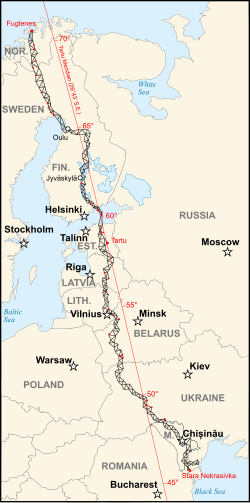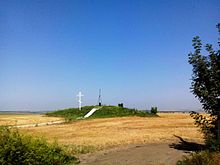This article needs additional citations for verification. (November 2012) |
| Struve Geodetic Arc | |
|---|---|
 The northernmost station of the Struve Geodetic Arc is located in Fuglenes, Norway. | |
 Map of the Struve Geodetic Arc where red points identify the World Heritage Sites. | |
| General information | |
| Type | Ensemble of memorable sites |
| Location | Estonia, Belarus, Finland, Latvia, Lithuania, Norway, Moldova, Russia, Sweden, and Ukraine |
| Coordinates | 59°3′28″N 26°20′16″E / 59.05778°N 26.33778°E |
| Opened | Geodetic Arc |
| Design and construction | |
| Architect(s) | Friedrich Georg Wilhelm von Struve |
| Official name | Struve Geodetic Arc |
| Criteria | ii, iii, vi |
| Reference | 1187 |
| Inscription | 2005 (29th Session) |




The Struve Geodetic Arc is a chain of survey triangulations stretching from Hammerfest in Norway to the Black Sea, through ten countries and over 2,820 kilometres (1,750 mi), which yielded the first accurate measurement of a meridian arc.[1]
The chain was established and used by the German-born Russian scientist Friedrich Georg Wilhelm von Struve in the years 1816 to 1855 to establish the exact size and shape of the earth. At that time, the chain passed merely through three countries: Norway, Sweden and the Russian Empire. The Arc's first point is located in Tartu Observatory in Estonia, where Struve conducted much of his research.[1] Measurement of the triangulation chain comprises 258 main triangles and 265 geodetic vertices.[2] The northernmost point is located near Hammerfest in Norway and the southernmost point near the Black Sea in Ukraine.
In 2005, the chain was inscribed on the World Heritage List, because of its importance in geodesy and its testimony to international scientific cooperation.[2] The World Heritage site includes 34 commemorative plaques or built obelisks out of the original 265 main station points which are marked by drilled holes in rock, iron crosses, cairns, others.[1] This inscription is located in ten countries, the second most of any UNESCO World Heritage after the Ancient and Primeval Beech Forests of the Carpathians and Other Regions of Europe.[1][3]
The measurements of the 30° Meridian Arc in 1816–1852 as well the description of the geodesic, topographical, and map making works in the Balkans from the nineteenth century until the beginning of the twentieth century by Russian Czarist Army was described in Astronomy, geodesy and map- drawing in Moldova since the middle ages till the World War I.[4]
- ^ a b c d Cite error: The named reference
norwas invoked but never defined (see the help page). - ^ a b "Struve Geodetic Arc". UNESCO World Heritage Centre. United Nations Educational, Scientific, and Cultural Organization. Retrieved 11 September 2021.
- ^ "Ancient and Primeval Beech Forests of the Carpathians and Other Regions of Europe". UNESCO World Heritage Centre. Retrieved 13 March 2021.
- ^ A. Găină, Astronomy, geodesy and map-drawing in Moldova since the middle ages till the World WarI, Serbian Astron. J., N.162 (2000), pp. 121–125